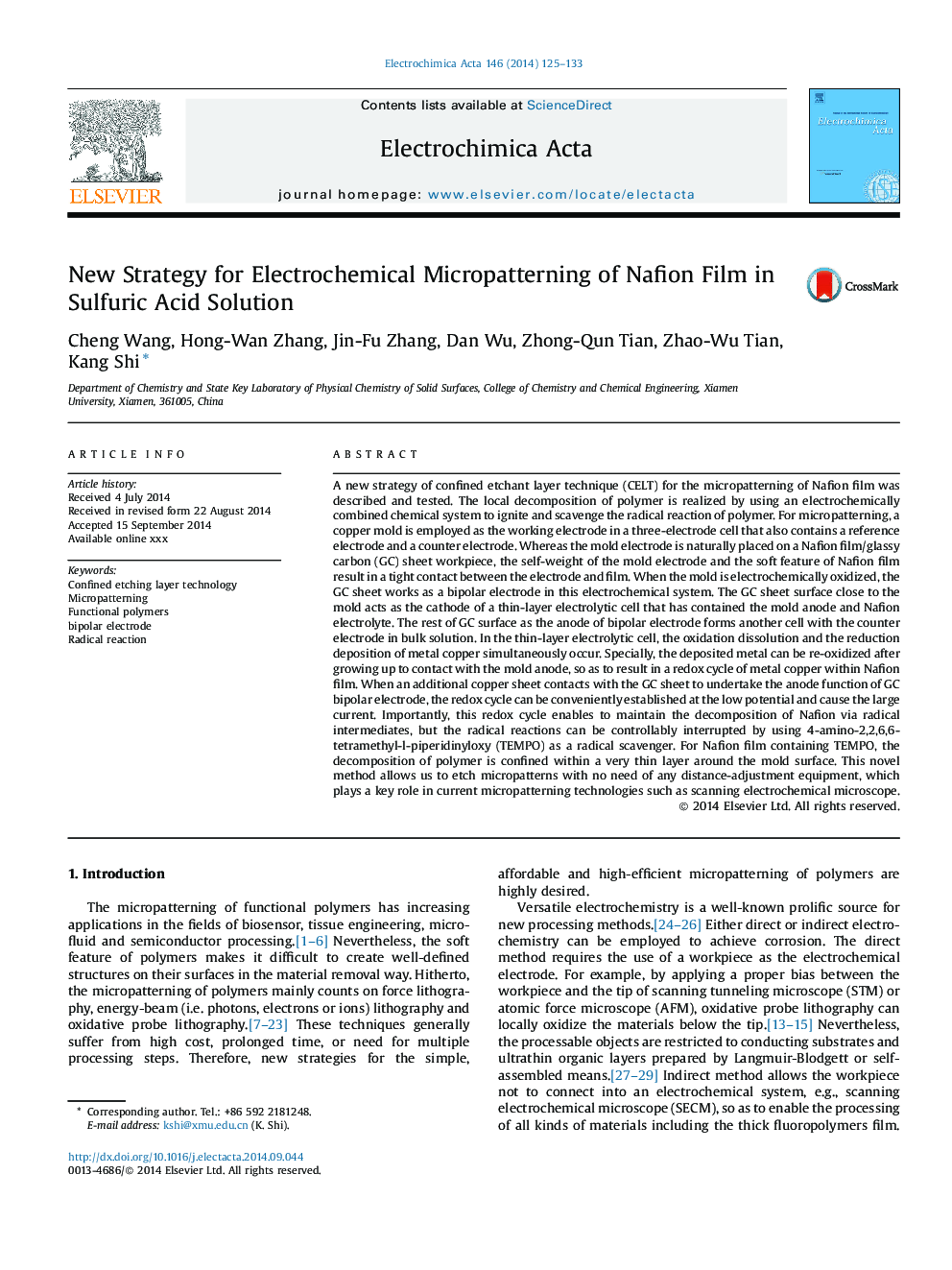| کد مقاله | کد نشریه | سال انتشار | مقاله انگلیسی | نسخه تمام متن |
|---|---|---|---|---|
| 6612739 | 459590 | 2014 | 9 صفحه PDF | دانلود رایگان |
عنوان انگلیسی مقاله ISI
New Strategy for Electrochemical Micropatterning of Nafion Film in Sulfuric Acid Solution
ترجمه فارسی عنوان
استراتژی جدید برای میکروفن الکتروشیمیایی فیلم نفیون در محلول اسید سولفوریک
دانلود مقاله + سفارش ترجمه
دانلود مقاله ISI انگلیسی
رایگان برای ایرانیان
کلمات کلیدی
موضوعات مرتبط
مهندسی و علوم پایه
مهندسی شیمی
مهندسی شیمی (عمومی)
چکیده انگلیسی
A new strategy of confined etchant layer technique (CELT) for the micropatterning of Nafion film was described and tested. The local decomposition of polymer is realized by using an electrochemically combined chemical system to ignite and scavenge the radical reaction of polymer. For micropatterning, a copper mold is employed as the working electrode in a three-electrode cell that also contains a reference electrode and a counter electrode. Whereas the mold electrode is naturally placed on a Nafion film/glassy carbon (GC) sheet workpiece, the self-weight of the mold electrode and the soft feature of Nafion film result in a tight contact between the electrode and film. When the mold is electrochemically oxidized, the GC sheet works as a bipolar electrode in this electrochemical system. The GC sheet surface close to the mold acts as the cathode of a thin-layer electrolytic cell that has contained the mold anode and Nafion electrolyte. The rest of GC surface as the anode of bipolar electrode forms another cell with the counter electrode in bulk solution. In the thin-layer electrolytic cell, the oxidation dissolution and the reduction deposition of metal copper simultaneously occur. Specially, the deposited metal can be re-oxidized after growing up to contact with the mold anode, so as to result in a redox cycle of metal copper within Nafion film. When an additional copper sheet contacts with the GC sheet to undertake the anode function of GC bipolar electrode, the redox cycle can be conveniently established at the low potential and cause the large current. Importantly, this redox cycle enables to maintain the decomposition of Nafion via radical intermediates, but the radical reactions can be controllably interrupted by using 4-amino-2,2,6,6-tetramethyl-l-piperidinyloxy (TEMPO) as a radical scavenger. For Nafion film containing TEMPO, the decomposition of polymer is confined within a very thin layer around the mold surface. This novel method allows us to etch micropatterns with no need of any distance-adjustment equipment, which plays a key role in current micropatterning technologies such as scanning electrochemical microscope.
ناشر
Database: Elsevier - ScienceDirect (ساینس دایرکت)
Journal: Electrochimica Acta - Volume 146, 10 November 2014, Pages 125-133
Journal: Electrochimica Acta - Volume 146, 10 November 2014, Pages 125-133
نویسندگان
Cheng Wang, Hong-Wan Zhang, Jin-Fu Zhang, Dan Wu, Zhong-Qun Tian, Zhao-Wu Tian, Kang Shi,
